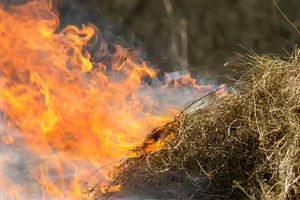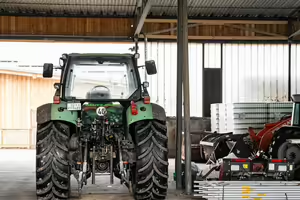Title
Statistics
In 2022, there were 63 cases of fires that affected farms in Illinois. There were 10 people injured, with eight injuries resulting in deaths. Most of the cases involved building damage (53 of the 63). Some of the fires were reported to be costly and affected storage sheds that destroyed large amounts of farm equipment. A few of the fire incidents involved livestock facilities that resulted in livestock deaths (6 of the 63), involving horses, poultry, and swine. Fires were most common in February with 13 incidents, with the second most tied between March and July with 8 incidents each.
- Have 10-lb ABC fire extinguishers on hand (in farm buildings, mounted on tractors, combines, and other equipment)
- Keep areas clean of debris and maintain pathways to exits. Keep brush and tall vegetation clear from around buildings.
- Properly store hazardous products, such as pesticides, based on the manufacturer’s recommendations. Have proper labelling on electrical panels and ensure they are easily accessible.
- Keep flammable products, such as fuels, away from ignition sources. Keep machinery cleaned and well maintained.
- Only use equipment, such as stall fans or space heaters, while someone is there and use extension cords on a temporary basis.
- Before an incident occurs, make sure to develop a fire safety plans that identify exit routes for all workers and family members. In the case of a fire, call 911.
Case Studies

Danger to Livestock
A barn with horse stables was engulfed in flames when emergency personnel arrived at the scene. They fought the fire from the outside for six hours, with more than a dozen fire engines and trucks. The fire destroyed the barn and killed twelve horses, with another one receiving injuries. — February 2022

Hay Storage Fire
A barn that stored a large amount of hay was destroyed by a fire that occurred in the afternoon. The fires also traveled to a nearby swine barn that killed six hogs and shoats. The fire was first discovered by workers in a nearby field. There was a possibility of the fire being of an incendiary origin due to a few people sighted at the scene right before the fire. — June 2022

Hazards During Harvest
State-owned farmland caught fire in the afternoon due to a combine during harvest. Dirt and debris accumulated on the combine and were in the process of getting cleaned when hot dust caught the ground on fire. Firefighters arrived on the scene and fought the fire for over two hours to get it under control, resulting in 20 acres being burnt. — October 2022

Farm Shed Misfortune
A farm shed caught fire in the early morning and resulted in an estimate of $2 million in damage, including farm tractors and semi-trailers. Firefighters were able to contain the fire to just this shed, though there were concerns about the fire spreading to nearby fuel tanks and other sheds. One of the main issues with fighting the fire was having to haul water to the site. — August 2022

Dry Field Dangers
A rural soybean field caught fire around the 4th of July. The cause of the fire was due to youth launching fireworks off in the area. Firefighters arrived on scene and fought the fire for over an hour. Seven acres of the field were burned before the flames could be eradicated. — July 2022
Additional Resources
- Farm Fire Risks and Prevention Factsheet (PDF), University of Illinois
- Farm Fire Prevention Guide (PDF), Iowa's Center for Agricultural Safety and Health
- Fire Prevention and Safety Measures Around the Farm, New Jersey Agricultural Experiment Station, Rutgers University